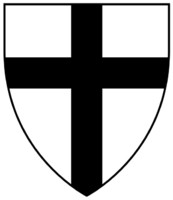Poland - The teutonic knights and castles
The Order of Brothers of the German House of Saint Mary in Jerusalem (Official names: Latin: Ordo domus Sanctæ Mariæ Theutonicorum Hierosolymitanorum, German: Orden der Brüder vom Deutschen Haus St. Mariens in Jerusalem), commonly the Teutonic Order (Today: German Order = Deutscher Orden, also Deutschherrenorden or Deutschritterorden), was a German medieval military order, and became in modern times a purely religious Catholic order. It was formed to aid Christians on their pilgrimages to the Holy Land and to establish hospitals. Its members have commonly been known as the Teutonic Knights, since they also served as a crusading military order in the Middle Ages. The military membership was always small, with volunteers and mercenaries augmenting the force as needed.
Formed at the end of the 12th century in Acre, in the Levant, the medieval Order played an important role in Outremer, controlling the port tolls of Acre. After Christian forces were defeated in the Middle East, the Order moved to Transylvania in 1211 to help defend the South-Eastern borders of the Kingdom of Hungary against the Kipchaks. The Knights were expelled by force of arms by king Andrew II of Hungary in 1225, after allegedly attempting to place themselves under Papal instead of the original Hungarian sovereignty.
In 1230, following the Golden Bull of Rimini, Grand Master Hermann von Salza and Duke Konrad I of Masovia launched the Prussian Crusade, a joint invasion of Prussia intended to Christianize the Baltic Old Prussians. The Knights had quickly taken steps against their Polish hosts and with the Emperor's support had changed the status of Chełmno Land (also Ziemia Chelminska or Kulmerland), where they were invited by the Polish prince into their own property. Starting from Chełmno Land the Order created the independent Monastic State of the Teutonic Knights adding continuously the conquered Prussian's territory, and subsequently conquered Livonia. The Kings of Poland accused the Order of holding lands rightfully theirs, specifically Chełmno Land and the Polish Kingdom's lands conquered later, such as Pomerelia (also Pomorze Gdańskie or Pomerania), Kujawy, Dobrzyń Land etc..
The Order lost its main purpose in Europe with the Christianization of Lithuania. The Order initiated numerous campaigns against its Christian neighbours, the Kingdom of Poland, the Grand Duchy of Lithuania, and the Novgorod Republic (after assimilating the Livonian Order). The Teutonic Knights had a strong economic base, hired mercenaries from throughout Europe to augment their feudal levies, and became a naval power in the Baltic Sea. In 1410, a Polish-Lithuanian army decisively defeated the Order and broke its military power at the Battle of Grunwald (Tannenberg).
In 1515, Holy Roman Emperor Maximilian I made a marriage alliance with Sigismund I of Poland-Lithuania. Thereafter the Empire did not support the Order against Poland. In 1525, Grand Master Albert of Brandenburg resigned and converted to Lutheranism, becoming Duke of Prussia as a vassal of Poland. Soon after, the Order lost Livonia and its holdings in the Protestant areas of Germany.
The Order kept its considerable holdings in Catholic areas of Germany until 1809, when Napoleon Bonaparte ordered its dissolution and the Order lost its last secular holdings. The Order continued to exist as a charitable and ceremonial body. It was outlawed by Adolf Hitler in 1938 but re-established in 1945. Today it operates primarily with charitable aims in Central Europe.
The Knights wore white surcoats with a black cross. A cross pattée was sometimes used as their coat of arms; this image was later used for military decoration and insignia by the Kingdom of Prussia and Germany as the Iron Cross and Pour le Mérite. The motto of the Order was: "Helfen, Wehren, Heilen" ("Help, Defend, Heal").





























